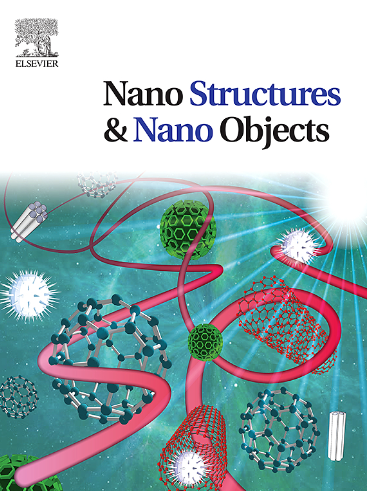Solvothermal synthesis of CZTS nano-structure based-electrospun PAN nanofibers impact on characterizations and antibacterial activity
IF 5.45
Q1 Physics and Astronomy
引用次数: 0
Abstract
The study focused on the solvothermal approach to synthesize Cu2ZnSnS4 (CZTS) nanoparticles (NPs) with an average particle size of 50 nm. At the same time, the composite nanofibers were fabricated from PAN-CZTS using the electrospinning method. XRD analysis confirmed the formation of the kesterite CZTS phase, while the functional groups revealed the chemical properties of the as-prepared samples via FTIR analysis. The FESEM images of CZTS indicated the appearance of quasi-spherical and nanoworm shapes, also a uniform nanofiber from PAN and PAN-CZTS with average diameters, descending order from 145 to 127 nm. The EDXs showed the compositional elements for as prepared samples. The TEM image proved the inclusion of CZTS NPs within polymer matrix. The significant highest absorption of CZTS is exhibited in the Vis region at about 400 nm, while at 260 nm in the UV region for nanocomposites, which makes it suitable applications in optoelectronic. Additionally, the values of the indirect optical band gap ( decreased from 3.6 to 2.6 eV using the Tauc model and confirmed by the imaginary dielectric constant . The high real dielectric constant and low imaginary dielectric constant values displayed that the prepared films can be used in the manufacture of optical energy storage devices. Furthermore, the CZTS-encapsulated PAN nanofiber demonstrated notable antibacterial activity against four bacterial strains, with maximum inhibition zones (23 ± 1.25 mm) for Staphylococcus aureus. This makes it useful in the medical field.
溶剂热合成CZTS纳米结构静电纺PAN纳米纤维对其性能和抗菌活性的影响
采用溶剂热法制备了平均粒径为50 nm的Cu2ZnSnS4 (CZTS)纳米粒子。同时,采用静电纺丝法制备了PAN-CZTS复合纳米纤维。XRD分析证实了kesterite CZTS相的形成,FTIR分析表征了其官能团的化学性质。从FESEM图像可以看出,PAN和PAN-CZTS的纳米纤维呈准球形和纳米蠕虫状,其平均直径从145 ~ 127 nm依次递减。edx显示了制备样品的组成元素。TEM图像证实了CZTS NPs存在于聚合物基体中。纳米复合材料在可见光区(400 nm)和紫外区(260 nm)的吸光度最高,这使其在光电领域具有良好的应用前景。此外,间接光学带隙(Eg indirect .opt)的值从3.6 eV下降到2.6 eV,并由虚介电常数(Egεi)证实。高的实介电常数和低的虚介电常数表明所制备的薄膜可用于制造光储能器件。此外,经czts包封的PAN纳米纤维对4种细菌均有明显的抑菌活性,对金黄色葡萄球菌的最大抑菌带为23±1.25 mm。这使得它在医学领域很有用。
本文章由计算机程序翻译,如有差异,请以英文原文为准。
求助全文
约1分钟内获得全文
求助全文
来源期刊

Nano-Structures & Nano-Objects
Physics and Astronomy-Condensed Matter Physics
CiteScore
9.20
自引率
0.00%
发文量
60
审稿时长
22 days
期刊介绍:
Nano-Structures & Nano-Objects is a new journal devoted to all aspects of the synthesis and the properties of this new flourishing domain. The journal is devoted to novel architectures at the nano-level with an emphasis on new synthesis and characterization methods. The journal is focused on the objects rather than on their applications. However, the research for new applications of original nano-structures & nano-objects in various fields such as nano-electronics, energy conversion, catalysis, drug delivery and nano-medicine is also welcome. The scope of Nano-Structures & Nano-Objects involves: -Metal and alloy nanoparticles with complex nanostructures such as shape control, core-shell and dumbells -Oxide nanoparticles and nanostructures, with complex oxide/metal, oxide/surface and oxide /organic interfaces -Inorganic semi-conducting nanoparticles (quantum dots) with an emphasis on new phases, structures, shapes and complexity -Nanostructures involving molecular inorganic species such as nanoparticles of coordination compounds, molecular magnets, spin transition nanoparticles etc. or organic nano-objects, in particular for molecular electronics -Nanostructured materials such as nano-MOFs and nano-zeolites -Hetero-junctions between molecules and nano-objects, between different nano-objects & nanostructures or between nano-objects & nanostructures and surfaces -Methods of characterization specific of the nano size or adapted for the nano size such as X-ray and neutron scattering, light scattering, NMR, Raman, Plasmonics, near field microscopies, various TEM and SEM techniques, magnetic studies, etc .
 求助内容:
求助内容: 应助结果提醒方式:
应助结果提醒方式:


